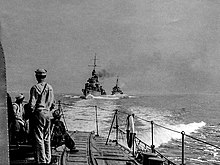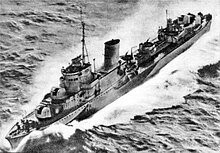Operation Beijing
The Peking Plan (including Beijing Plan ) was a successful Polish Navy operation on August 29, 1939 shortly before the Second World War was initiated. The aim of the operation was to move the large Polish surface units to Great Britain , from where they continued to operate against Germany .
The three destroyers were relocated :
Strategic starting position
Shortly before the German invasion of Poland on September 1, 1939, the balance of forces in the Baltic Sea was as follows:
|
|
|
|
|---|---|---|
| Battleships / ships of the line | 2 | 0 |
| Light cruisers | 3 | 0 |
| destroyer | 10 | 4th |
| Minesweepers | 30th | 6th |
| Submarines | 10 | 5 |
German Navy : (active warships in the Baltic Sea )
- 2 ships of the line ( Schleswig-Holstein , Silesia )
- 3 light cruisers ( Nuremberg , Cologne and Leipzig )
- 10 destroyers ( Z 1 Leberecht Maass , Z 2 Georg Thiele , Z 4 Richard Beitzen , Z 8 Bruno Heinemann , Z 9 Wolfgang Zenker , Z 10 Hans Lody , Z 11 Bernd von Arnim , Z 14 Friedrich Ihn , Z 15 Erich Steinbrinck and Z 16 Friedrich Eckoldt )
- 4 supply ships
- 30 minesweepers
- 10 submarines
- various underground hunters
- 4 destroyers ( ORP Wicher , ORP Burza , ORP Błyskawica and ORP Grom )
- 1 heavy mine-layer ( ORP Gryf )
- 5 submarines ( ORP Orzeł , ORP Ryś , ORP Sęp , ORP Wilk and ORP Żbik )
- 2 gunboats ( ORP Komendant Piłsudski and ORP Generał Haller )
- 6 minesweepers ( ORP Czajka , ORP Rybitwa , ORP Mewa , ORP Czapla , ORP Jaskółka and ORP Żuraw )
- several smaller units
The three destroyers ORP Burza , ORP Błyskawica and ORP Grom , which together formed a division ( Polish name: Dywizjon Kontrtorpedowców ) at sea, were to be relocated to British ports, as the Polish high command realized that the overwhelming German superiority of the Polish surface units did not Chance. It also expected that the Navy and Air Force would have quick access to the waterways between Denmark and Sweden , which is why the relocation had to begin before the outbreak of combat .
procedure
On August 25, 1939, Poland and Great Britain signed a mutual assistance pact. A day later, the commander of the Polish Navy, Rear Admiral Józef Unrug, confirmed the order for the Beijing plan . The order was sent in sealed envelopes to the commanders of the three affected destroyers.
On August 29, at 12:55 p.m., the three ships received the signal “Beijing, Beijing, Beijing” from the Polish Commander-in-Chief Marshal Edward Rydz-Śmigły . The seals of the secret order Beijing Plan were broken and commanders Włodzimierz Kodrębski ( ORP Błyskawica ), Stanisław Nahorski ( ORP Burza ) and Aleksander Hulewicz ( ORP Grom ) learned of their mission. Roman Stankiewicz was in command of the division.
The ships left at 2:15 p.m., crossed the Baltic Sea without any problems and reached the Øresund at midnight . During the crossing, the association encountered the German light cruiser Königsberg (at that time a training ship ) and also a destroyer . Since the war had not yet started, there was no fighting.
The next day the three Polish ships crossed the Kattegat and reached the Skagerrak .
During August 31, German maritime patrols sighted the Polish destroyers. The association changed course towards Norway to return to the original course under cover of darkness.
At 9:45 a.m. on September 1, the association was informed of the German attack on Poland. At around 1 p.m., the ships met the British destroyers HMS Wanderer and HMS Wallace , from whom a liaison officer was taken over. At 17:37 the Polish Naval Union reached Edinburgh , Scotland .
Results
The Peking Plan was initially very controversial in Poland, after all, the most powerful units of the Polish Navy were withdrawn before the start of the competition out of the combat zone.
The story of the abandoned units ORP Wicher and ORP Gryf , which were sunk within the first three days of the war, shows that the Beijing plan was the right decision. Although the remaining large units were able to defend themselves against the navy, the superior strength of the German armed forces could not be countered from the Polish point of view. Even Polish successes at sea would not have changed the course of the war on land; the ships would have to flee anyway, which they probably would not have succeeded in doing.
The German light cruisers intended for the attack on the three Polish destroyers did not find their intended target and were indirectly neutralized by Operation Peking .
The Beijing plan enabled valuable units and their crews to be retained by the Allies , which could achieve more in the further course of the war than in September 1939 in the Baltic Sea.
ORP Błyskawica and ORP Burza survived the war and then returned to Poland. ORP Grom was lost on May 4, 1940 during the German invasion of Norway .
See also
literature
- MJ Whitley: Destroyers in World War II , Motorbuchverlag, Stuttgart, 2nd edition 1997, ISBN 3-613-01426-2
Explanations
- ↑ ORP is the abbreviation for Okręt Rzeczypospolitej Polskiej and the name prefix of Polish ships. ORP means ship of the Republic of Poland .
- ↑ only the units used for the white case are mentioned. Inactive units in the Baltic Sea or units in other sea areas (e.g. North Sea ) are not considered.
- ^ Text of the mutual assistance pact without additional protocol


